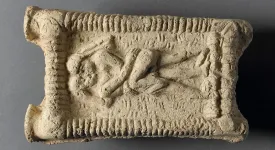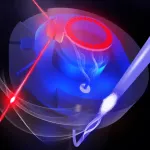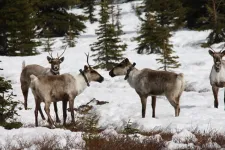(Press-News.org) Medium-sized carnivorous species – mesopredators like coyotes or bobcats – tend to move into human-dominated areas to avoid predation by larger carnivores, a phenomenon also known as the “human shield” effect. However, according to a new study, doing so places these safety-seeking species at considerably greater risk for mortality due to human activities. The findings describe a “paradox of the lethal human shield” for mesopredators, which could become an increasingly important driver of carnivore community dynamics and ecological trophic structures as species restoration and recovery efforts expand the coexistence of large predators and humans in shared landscapes. Although the use of human shields has been linked to increased wildlife survival rates in some instances, it also has the potential to impose increased risk for human-caused mortality through hunting, human-wildlife conflict removals, or vehicular collisions. However, the interacting dangers posed by large carnivores and humans affect the behavior and mortality of smaller predators remains poorly understood. Using data from radio-collared coyotes and bobcats (mesopredators), as well as wolves and cougars (sympatric large carnivores), Laura Prugh and colleagues investigated the movements of these animals in relation to one another and in relation to substantial human activities across northern Washington state. Prugh et al. found that smaller predators tended to move away from the larger predators into areas with greater human influence, suggesting the smaller species perceived humans to be less of a threat than larger carnivores. However, rather than shielding mesopredators and improving their overall survival, the authors discovered that the human-caused mortality rates for mesopredators were more than three times higher than large-carnivore-caused mortality in these areas. Prugh et al. suggest that this scenario could represent an ecological trap. “Despite uncertainty among underlying behavioral and evolutionary processes, the study by Prugh et al. highlights the ecological implications of human influence on relationships among multiple trophic levels,” write Chris Darimont and Ishana Shukla in a related Perspective.
END
Fear of large predators drives smaller predators into areas they perceive as safer, but where risk is greater
2023-05-18
ELSE PRESS RELEASES FROM THIS DATE:
Ancient history of kissing and its role in disease transmission
2023-05-18
In a Perspective, Troels Arbøll and Sophie Rasmussen review the ancient history of kissing, particularly the emergence of romantic-sexual kissing in Mesopotamia more than 4000 years ago and its role in the evolution and spread of orally transmitted diseases like herpes simplex virus 1 (HSV-1). They say the kiss cannot be regarded as a sudden biological trigger causing a spread of specific pathogens, as some research has recently proposed. “Evidence indicates that kissing was a common practice in ancient times, potentially representing a constant influence on the spread of orally transmitted microbes, such as HSV-1,” ...
Global analysis reveals widespread decline in lake water storage worldwide
2023-05-18
The amount of water stored in more than half of the largest lakes and reservoirs worldwide is declining, according to a new study. This drying is largely attributable to a warming climate and increased human impacts. The findings underscore the importance of accounting for these impacts in future surface water resources management strategies. Although they cover roughly 3% of the global land area, lakes hold 87% of Earth’s liquid surface fresh water. These features also provide essential ecosystem services and are key components in global biogeochemical processes. Many of these benefits are modulated by lake water storage (LWS), which ...
Unmanaged global forests have limited carbon sequestration potential
2023-05-18
Even if all direct human management of global forests ended immediately, their carbon sequestration potential would not be enough to curb ongoing climate change, according to a new study. The findings suggest that the planet’s current forests have only limited remaining carbon storage potential – even under the most unlikely of scenarios – to substantially mitigate atmospheric carbon dioxide (CO2) without major reductions in emissions. By capturing and storing carbon in biomass and soil organic matter, forests are integral to the global carbon cycle. As a result, the planet’s forests are often considered a central component in climate ...
Half of world's largest lakes losing water
2023-05-18
More than 50 percent of the largest lakes in the world are losing water, according to a groundbreaking new assessment published today in Science . The key culprits are not surprising: warming climate and unsustainable human consumption.
But lead author Fangfang Yao, a CIRES visiting fellow, now a climate fellow at University of Virginia, said the news is not entirely bleak. With this new method of tracking lake water storage trends and the reasons behind them, scientists can give water managers and communities insight into how to better protect critical sources of water and important regional ecosystems.
“This is the first comprehensive assessment of trends ...
Humanity’s earliest recorded kiss occurred in Mesopotamia 4,500 years ago
2023-05-18
Recent research has hypothesised that the earliest evidence of human lip kissing originated in a very specific geographical location in South Asia 3,500 years ago, from where it may have spread to other regions, simultaneously accelerating the spread of the herpes simplex virus 1.
But according to Dr Troels Pank Arbøll and Dr Sophie Lund Rasmussen, who in a new article in the journal Science draw on a range of written sources from the earliest Mesopotamian societies, kissing was already a well-established ...
Wiring up quantum circuits with light
2023-05-18
Quantum computers promise to solve challenging tasks in material science and cryptography that will remain out of reach even for the most powerful conventional supercomputers in the future. Yet, this will likely require millions of high-quality qubits due to the required error correction.
Progress in superconducting processors advances quickly with a current qubit count in the few hundreds. The advantages of this technology are the fast computing speed and its compatibility with microchip fabrication, but the need for ultra-cold temperatures ultimately confines the processor in size and prevents any physical ...
Call for Canada, US to braid Indigenous rights, endangered species laws
2023-05-18
Climbing caribou numbers in northeastern British Columbia prove that collaborations between Indigenous and colonial governments can reverse decades-long declines, but focus needs to shift to culturally meaningful recovery targets, a consortium of researchers and community members say in a new paper published this week in Science.
UBC Okanagan’s Dr. Clayton Lamb and West Moberly First Nation Chief Roland Willson co-lead the paper, Braiding Indigenous Rights and Endangered Species Law, alongside nine others for the influential journal.
“Abundance matters. There are many cases where endangered species laws have prevented extinction, but the warning signs ...
Rising rates of induced labor need to be reconsidered in the context of the UK maternity services staffing crisis, study suggests
2023-05-18
A new study suggests that increasing rates of induction of labour (IOL) of pregnant women and people in the UK, without considering the accompanying, real-world impact on staffing workloads and patient care, may have unintended consequences.
The study from City, University of London, the University of Edinburgh and others highlights the limited evidence around the delivery of home-based IOL services, which were seen as an important step to reducing maternity staff workload.
It finds large gaps in knowledge on how to deliver home-based ...
Disentanglement——breaking the activity-selectivity “tradeoff” effect in catalytic conversion
2023-05-18
Researchers have reported a strategy to disentangle the activity-selectivity tradeoff for direct conversion of syngas, a mixture of carbon monoxide and hydrogen, into desirable ethylene, propylene, and butylene. These hydrocarbons are known as light olefins and are the most-used building blocks for plastics.
“Activity and selectivity are two primary indexes of a successful catalyst for chemical reactions. A higher activity means higher efficiency in converting feedstock to products, thereby reducing energy consumption,” said JIAO Feng, an associate professor at the ...
Perfection: The Enemy of Evolution
2023-05-18
DURHAM, N.C. -- Scientists are often trained to seek out the absolute best solution to a given problem. On a chalk board, this might look something like drawing a graph to find a function’s minimum or maximum point. When designing a turbojet engine, it might mean tweaking the rotor blades’ angles a tiny degree to achieve a tenth of a percent increase in efficiency.
Adrian Bejan, the J.A. Jones Distinguished Professor of Mechanical Engineering at Duke University, was busy demonstrating the former for a class full of students ...



